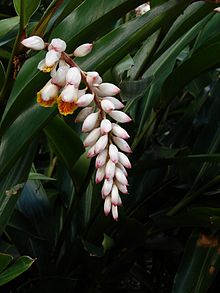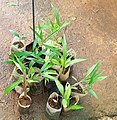| Alpinia | |
|---|---|

| |
| Alpinia zerumbet | |
| Scientific classification | |
| Kingdom: | Plantae |
| Clade: | Tracheophytes |
| Clade: | Angiosperms |
| Clade: | Monocots |
| Clade: | Commelinids |
| Order: | Zingiberales |
| Family: | Zingiberaceae |
| Subfamily: | Alpinioideae |
| Tribe: | Alpinieae |
| Genus: | Alpinia Roxb., 1810 |
| Species | |
|
See text | |
| Synonyms[1] | |
|
20 synonyms
| |
Alpinia is a genus of flowering plants in the ginger family, Zingiberaceae. Species are native to Asia, Australia, and the Pacific Islands, where they occur in tropical and subtropical climates.[2] Several species are cultivated as ornamental plants.[3]
Taxonomy[edit]
The genus was erected by the Scottish botanist William Roxburgh in 1810, and published in the journal Asiatic Researches[4] It is named after Prospero Alpini, a 17th-century Italian botanist who specialized in exotic plants.[5] Species of the genus are known generally as shell gingers.[3][6]
Description[edit]


These herbs lack true stems, but have pseudostems usually up to about 3 metres (9.8 ft) long which are composed of the overlapping leaf sheaths.[2][3] A few species have been known to reach 8 metres (26 ft).[7] They grow from thick rhizomes. The leaves are lance-shaped to oblong. The inflorescence takes the form of a spike, a panicle, or a raceme. It may be hooded in bracts and bracteoles. The flower has a shallowly toothed calyx which is sometimes split on one side. The flower corolla is a cylindrical tube with three lobes at the mouth, the middle lobe larger and hoodlike in some taxa. There is one fertile stamen and two staminodes, which are often joined into a petal-like labellum, a structure that is inconspicuous in some species and quite showy in others. The fruit is a rounded, dry or fleshy capsule.[2][3] The plants are generally aromatic due to their essential oils.[8]
Species[edit]
This is the largest genus in the ginger family,[7] with 245 species and 2 hybrids accepted by Plants of the World Online as of 4 March 2024[update].[1] A number of those are commonly grown for their flowers, including red ginger, and others are used as spices, including Galangal.
Accepted species:
- Alpinia abundiflora Burtt & R.M.Sm.
- Alpinia acuminata R.M.Sm.
- Alpinia adana C.K.Lim
- Alpinia aenea B.L.Burtt & R.M.Sm.
- Alpinia albipurpurea (P.Royen) R.M.Sm.
- Alpinia amentacea R.M.Sm.
- Alpinia apoensis Elmer
- Alpinia aquatica (Retz.) Roscoe
- Alpinia arctiflora (F.Muell.) Benth.
- Alpinia arfakensis K.Schum.
- Alpinia argentea (B.L.Burtt & R.M.Sm.) R.M.Sm.
- Alpinia arundelliana (F.M.Bailey) K.Schum.
- Alpinia asmy C.K.Lim
- Alpinia assimilis Ridl.
- Alpinia athroantha Valeton
- Alpinia austrosinense (D.Fang) P.Zou & Y.S.Ye
- Alpinia bambusifolia C.F.Liang & D.Fang
- Alpinia beamanii R.M.Sm.
- Alpinia biakensis R.M.Sm.
- Alpinia bodenii R.M.Sm.
- Alpinia boia Seem.
- Alpinia boninsimensis Makino
- Alpinia borraginoides K.Schum.
- Alpinia brachyantha Merr.
- Alpinia brevilabris C.Presl
- Alpinia breviligulata (Gagnep.) Gagnep.
- Alpinia brevis T.L.Wu & S.J.Chen
- Alpinia caerulea (R.Br.) Benth. – Australian native ginger
- Alpinia calcarata (Andrews) Roscoe – heen araththa, cardamom ginger
- Alpinia calcicola Q.B.Nguyen & M.F.Newman
- Alpinia calycodes K.Schum.
- Alpinia capitellata Jack
- Alpinia carinata Valeton
- Alpinia carolinensis Koidz.
- Alpinia celebica K.Schum.
- Alpinia chaunocolea K.Schum.
- Alpinia chinensis (Retz.) Roscoe
- Alpinia chrysorachis K.Schum.
- Alpinia coeruleoviridis K.Schum.
- Alpinia conchigera Griff. – lesser alpinia
- Alpinia condensata Valeton
- Alpinia conferta B.L.Burtt & R.M.Sm.
- Alpinia congesta Elmer
- Alpinia conghuaensis J.P.Liao & T.L.Wu
- Alpinia conglomerata R.M.Sm.
- Alpinia copelandii Ridl.
- Alpinia coriacea T.L.Wu & S.J.Chen
- Alpinia coriandriodora D.Fang
- Alpinia corneri (Holttum) R.M.Sm.
- Alpinia cumingii K.Schum.
- Alpinia cylindrocephala K.Schum.
- Alpinia dasystachys Valeton
- Alpinia dekockii Valeton
- Alpinia densibracteata T.L.Wu & S.J.Chen
- Alpinia densiflora K.Schum.
- Alpinia denticulata (Ridl.) Holttum
- Alpinia diffissa Roscoe
- Alpinia divaricata Valeton
- Alpinia diversifolia (Elmer) Elmer
- Alpinia domatifera Valeton
- Alpinia elegans (C.Presl) K.Schum.
- Alpinia elmeri R.M.Sm.
- Alpinia emaculata S.Q.Tong
- Alpinia epiphytica Meekiong, Ipor & Tawan
- Alpinia eremochlamys K.Schum.
- Alpinia euastra K.Schum.
- Alpinia eubractea K.Schum.
- Alpinia fax B.L.Burtt & R.M.Sm.
- Alpinia flabellata Ridl.
- Alpinia flagellaris (Ridl.) Loes.
- Alpinia formosana K.Schum.
- Alpinia foxworthyi Ridl.
- Alpinia fusiformis R.M.Sm.
- Alpinia gagnepainii K.Schum.
- Alpinia galanga (L.) Willd. – greater galangal
- Alpinia gigantea Blume
- Alpinia glabra Ridl.
- Alpinia glabrescens Ridl.
- Alpinia glacicaerulea R.M.Sm.
- Alpinia globosa (Lour.) Horan. – round Chinese cardamom
- Alpinia gracillima Valeton
- Alpinia graminea Ridl.
- Alpinia guinanensis D.Fang & X.X.Chen
- Alpinia haenkei C.Presl
- Alpinia hagena R.M.Sm.
- Alpinia hainanensis K.Schum.
- Alpinia hansenii R.M.Sm.
- Alpinia havilandii K.Schum.
- Alpinia hibinoi Masam.
- Alpinia himantoglossa Ridl.
- Alpinia hirsuta (Lour.) Horan.
- Alpinia hongiaoensis Tagane
- Alpinia horneana K.Schum.
- Alpinia hulstijnii Valeton
- Alpinia hylandii R.M.Sm.
- Alpinia × ilanensis S.C.Liu & J.C.Wang
- Alpinia illustris Ridl.
- Alpinia inaequalis (Ridl.) Loes.
- Alpinia intermedia Gagnep.
- Alpinia janowskii Valeton
- Alpinia japonica (Thunb.) Miq.
- Alpinia javanica Blume' – Javanese alpinia
- Alpinia jianganfeng T.L.Wu
- Alpinia jingxiensis D.Fang
- Alpinia juliformis (Ridl.) R.M.Sm.
- Alpinia kawakamii Hayata
- Alpinia kiungensis R.M.Sm.
- Alpinia klossii (Ridl.) R.M.Sm.
- Alpinia koidzumiana Kitam.
- Alpinia koshunensis Hayata
- Alpinia kusshakuensis Hayata
- Alpinia kwangsiensis T.L.Wu & S.J.Chen
- Alpinia lalashanensis S.S.Ying
- Alpinia laosensis Gagnep.
- Alpinia latilabris Ridl.
- Alpinia lauterbachii Valeton
- Alpinia laxisecunda B.L.Burtt & R.M.Sm.
- Alpinia leptostachya Valeton
- Alpinia ligulata K.Schum.
- Alpinia ludwigiana R.M.Sm.
- Alpinia maclurei Merr.
- Alpinia macrocephala K.Schum.
- Alpinia macrocrista Ardiyani & Ardi
- Alpinia macroscaphis K.Schum.
- Alpinia macrostaminodia Chaveer. & Sudmoon
- Alpinia macrostephana (Baker) Ridl.
- Alpinia macroura K.Schum.
- Alpinia malaccensis (Burm.f.) Roscoe – rathkihiriya
- Alpinia manii Baker
- Alpinia manostachys Valeton
- Alpinia martini R.M.Sm.
- Alpinia maxii R.M.Sm.
- Alpinia melichroa K.Schum.
- Alpinia menghaiensis S.Q.Tong & Y.M.Xia
- Alpinia mesanthera Hayata
- Alpinia microlophon Ridl.
- Alpinia modesta F.Muell. ex K.Schum.
- Alpinia mollis C.Presl
- Alpinia mollissima Ridl.
- Alpinia monopleura K.Schum.
- Alpinia multispica (Ridl.) Loes.
- Alpinia murdochii Ridl.
- Alpinia musifolia Ridl.
- Alpinia mutica Roxb. – small shell ginger, orchid ginger, narrow-leaved alpinia
- Alpinia myriocratera K.Schum.
- Alpinia nantoensis F.Y.Lu & Y.W.Kuo
- Alpinia napoensis H.Dong & G.J.Xu
- Alpinia newmanii N.S.Lý
- Alpinia nidus-vespae A.Raynal & J.Raynal
- Alpinia nieuwenhuizii Valeton
- Alpinia nigra (Gaertn.) Burtt
- Alpinia nobilis Ridl.
- Alpinia novae-hiberniae B.L.Burtt & R.M.Sm.
- Alpinia novae-pommeraniae K.Schum.
- Alpinia nutans (L.) Roscoe – dwarf cardamom, ginger lily, shell ginger
- Alpinia oblongifolia Hayata
- Alpinia odontonema K.Schum.
- Alpinia officinarum Hance – lesser galangal, Chinese ginger
- Alpinia × okinawaensis Tawada
- Alpinia oligantha Valeton
- Alpinia orientalis Docot & Banag
- Alpinia orthostachys K.Schum.
- Alpinia oui Y.H.Tseng & Chih C.Wang
- Alpinia ovata Z.L.Zhao & L.S.Xu
- Alpinia ovoidocarpa H.Dong & G.J.Xu
- Alpinia oxymitra K.Schum.
- Alpinia oxyphylla Miq. – sharp-leaf galangal
- Alpinia padacanca Valeton ex K.Heyne
- Alpinia pahangensis Ridl.
- Alpinia papuana Scheff.
- Alpinia parksii (Gillespie) A.C.Sm.
- Alpinia penduliflora Ridl.
- Alpinia petiolata Baker – stalked-leaved alpinia
- Alpinia pinnanensis T.L.Wu & S.J.Chen
- Alpinia platychilus K.Schum.
- Alpinia platylopha (Ridl.) Loes.
- Alpinia polyantha D.Fang
- Alpinia porphyrea R.M.Sm.
- Alpinia porphyrocarpa Ridl.
- Alpinia pricei Hayata
- Alpinia psilogyna D.Fang
- Alpinia ptychanthera K.Schum.
- Alpinia pubiflora (Benth.) K.Schum.
- Alpinia pulchella (K.Schum.) K.Schum.
- Alpinia pulcherrima Ridl.
- Alpinia pulchra (Warb.) K.Schum.
- Alpinia pumila Hook.f.
- Alpinia purpurata (Vieill.) K.Schum. – red ginger
- Alpinia pusilla Ardi & Ardiyani
- Alpinia rafflesiana Wall. ex Baker – Raffles' alpinia
- Alpinia regia K.Heyne ex R.M.Sm.
- Alpinia rigida Ridl.
- Alpinia romblonensis Elmer
- Alpinia romburghiana Valeton
- Alpinia rosacea Valeton
- Alpinia rosea Elmer
- Alpinia roxburghii Sweet
- Alpinia rubricaulis K.Schum.
- Alpinia rubromaculata S.Q.Tong
- Alpinia rufa (C.Presl) Náves
- Alpinia rufescens (Thwaites) K.Schum.
- Alpinia rugosa S.J.Chen & Z.Y.Chen
- Alpinia salomonensis B.L.Burtt & R.M.Sm.
- Alpinia samoensis Reinecke
- Alpinia sandsii R.M.Sm.
- Alpinia scabra (Blume) Náves
- Alpinia schultzei Lauterb. ex Valeton
- Alpinia seimundii Ridl.
- Alpinia sericiflora K.Schum.
- Alpinia sessiliflora Kitam.
- Alpinia shimadae Hayata
- Alpinia siamensis K.Schum.
- Alpinia sibuyanensis Elmer
- Alpinia singuliflora R.M.Sm.
- Alpinia smithiae M.Sabu & Mangaly
- Alpinia stachyodes Hance
- Alpinia stenobracteolata R.M.Sm.
- Alpinia stenostachys K.Schum.
- Alpinia strobilacea K.Schum.
- Alpinia strobiliformis T.L.Wu & S.J.Chen
- Alpinia subfusicarpa Elmer
- Alpinia submutica K.Schum.
- Alpinia subspicata Valeton
- Alpinia subverticillata Valeton
- Alpinia superba (Ridl.) Loes.
- Alpinia suriana C.K.Lim
- Alpinia tamacuensis R.M.Sm.
- Alpinia tonkinensis Gagnep.
- Alpinia tonrokuensis Hayata
- Alpinia trachyascus K.Schum.
- Alpinia tristachya (Ridl.) Loes.
- Alpinia unilateralis B.L.Burtt & R.M.Sm.
- Alpinia uraiensis Hayata
- Alpinia valetoniana Loes.
- Alpinia velutina Ridl.
- Alpinia velveta R.M.Sm.
- Alpinia versicolor K.Schum.
- Alpinia vietnamica H.Ð.Trần, Luu & Škorničk.
- Alpinia vitellina (Lindl.) Ridl.
- Alpinia vitiensis Seem.
- Alpinia vittata W.Bull – variegate-ginger
- Alpinia vulcanica Elmer
- Alpinia warburgii K.Schum.
- Alpinia wenzelii Merr.
- Alpinia werneri Lauterb. ex Valeton
- Alpinia womersleyi R.M.Sm.
- Alpinia zerumbet (Pers.) B.L.Bu – shell ginger
Distribution[edit]
The genus Alpinia is native to the countries (and regions) of; Andaman Islands, Assam, Bangladesh, Bismarck Archipelago, Bonin Islands, Borneo, Cambodia, Caroline Islands, southern China, East Himalaya, Fiji, Hainan, India, Japan, Java, Laos, Lesser Sunda Islands, Malaya, Maluku Islands, Myanmar, Nepal, New Caledonia, New Guinea, New South Wales, Nicobar Islands, Philippines, Queensland, Ryukyu Islands, Samoa, Solomon Islands, Sri Lanka, Sulawesi, Sumatra, Taiwan, Thailand, Tibet, Vanuatu, Vietnam and Volcano Islands.[1]
Ecology[edit]
Most Alpinia are plants of forest understory habitat. Most are pollinated by large bees, but some are pollinated by birds and bats.[7]
Uses[edit]
According to a research team of National Chung Hsing University, Alpinia was found to have anti-inflammatory, hypolipidemic, anti-tumor and other effects.[9]
Gallery[edit]
-
Alpinia hainanensis ' Shengzhen' from Flower View[10]
See also[edit]
References[edit]
- ^ a b c "Alpinia Roxb". Plants of the World Online. Royal Botanic Gardens, Kew. 2024. Retrieved 4 March 2024.
- ^ a b c Alpinia. Flora of China.
- ^ a b c d Alpinia. Flora of North America.
- ^ Roxburgh, William (1810). "Descriptions of several of the Monandrous Plants of India, belonging to the natural order called Scitamineae by Linnaeus, Cannae by Jussieu, and Drimyrhizae by Ventenat". Asiatic Researches. 11: 350. Retrieved 4 March 2024.
- ^ Simonetti, G. (1990). Stanley Schuler (ed.). Simon & Schuster's Guide to Herbs and Spices. Simon & Schuster, Inc. ISBN 0-671-73489-X.
- ^ Alpinia. Integrated Taxonomic Information System (ITIS).
- ^ a b c Kress, W. J., et al. (2005). "The molecular phylogeny of Alpinia (Zingiberaceae): a complex and polyphyletic genus of gingers". American Journal of Botany 92(1), 167-78.
- ^ Victório, C. P. (2011). "Therapeutic value of the genus Alpinia, Zingiberaceae". Revista Brasileira de Farmacognosia 21(1), 194-201.
- ^ 曾彥學、邱輝龍、吳佾鴻 (2017). 曾彥學 (ed.). 惠蓀饗宴 植栽食藥用植物圖鑑. 國立中興大學農業暨自然資源學院實驗林管理處. ISBN 978-986-04-7966-9.
- ^ Alpinia hainanensis ' Shengzhen'. "Alpinia hainanensis ' Shengzhen'". Flower View. Archived from the original on 2016-03-04. Retrieved 2015-09-12.






![Alpinia hainanensis ' Shengzhen' from Flower View[10]](https://upload.wikimedia.org/wikipedia/commons/thumb/f/f1/Alpinia_hainanensis_%27_Shengzhen%27_22.jpg/120px-Alpinia_hainanensis_%27_Shengzhen%27_22.jpg)